This is a continually updated photo gallery of street signs from around Thailand. Not only are street signs in many Thai towns beautiful, their creative designs are based on local landmarks, history, culture, legends, industries, etc. Click on each photo to see it large.
Central Thailand
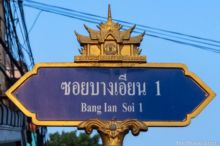
Ayutthaya city
The building represents the old royal palace, which was completely destroyed by the Burmese. I couldn't determine if it is a specific building or not, though it does bear a resemblance to a sketch I saw of the 1688 Banyong Rattanat Pavilion (aka Tai Sra Pavilion), which sat on a small island.
The building represents the old royal palace, which was completely destroyed by the Burmese. I couldn't determine if it is a specific building or not, though it does bear a resemblance to a sketch I saw of the 1688 Banyong Rattanat Pavilion (aka Tai Sra Pavilion), which sat on a small island.
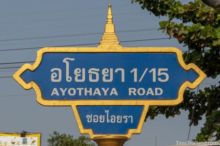
Ayutthaya city
These street signs are found around Wat Yai Chai Mongkhon temple, which has a large, historic stupa.
These street signs are found around Wat Yai Chai Mongkhon temple, which has a large, historic stupa.
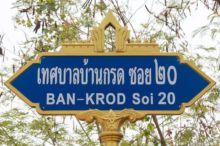
Ban Krot, Ayutthaya province
Though it no longer exists, there used to be a fortified city gate near Wat Kanon Neua.
Though it no longer exists, there used to be a fortified city gate near Wat Kanon Neua.
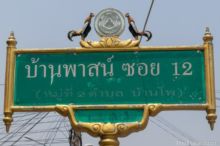
Ban Pho, Ayutthaya province
Many fighting chickens are raised here, a tradition going way back into the past.
Many fighting chickens are raised here, a tradition going way back into the past.
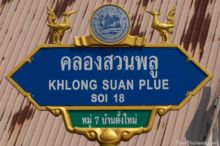
Ko Rian, Ayutthaya province
These are hong, mythical swan-like birds from the Himmapan Forest. They were chosen by the tambon government just because they looked nice.
These are hong, mythical swan-like birds from the Himmapan Forest. They were chosen by the tambon government just because they looked nice.
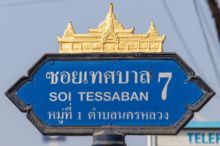
Nakhon Luang, Ayutthaya province
Prasat Nakhon Luang is an Ayutthaya-era palace converted to a Buddhist footprint shrine.
Prasat Nakhon Luang is an Ayutthaya-era palace converted to a Buddhist footprint shrine.

Phachi, Ayutthaya province
This town is on the train line and the stupa represents the area's most important temple, Wat Charoen Tham.
This town is on the train line and the stupa represents the area's most important temple, Wat Charoen Tham.
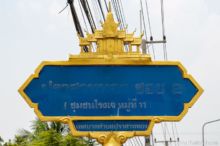
Prasat Thong, Ayutthaya province
This is Aisawan Dhipaya Asana Pavilion, one of the most beautiful buildings in the nearby Bang Pa-In Royal Palace.
This is Aisawan Dhipaya Asana Pavilion, one of the most beautiful buildings in the nearby Bang Pa-In Royal Palace.
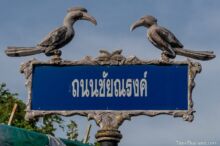
Chainat city
Chainat Bird Park was once a very popular tourist destination, hence the choice of hornbills.
Chainat Bird Park was once a very popular tourist destination, hence the choice of hornbills.
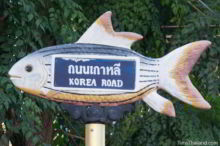
Kanchanaburi city
This fish is Jullien's golden carp (bplaa yisok), a popular food that is common in rivers here. Some say that if you don't eat it, you didn't really visit Kanchanaburi.
This fish is Jullien's golden carp (bplaa yisok), a popular food that is common in rivers here. Some say that if you don't eat it, you didn't really visit Kanchanaburi.
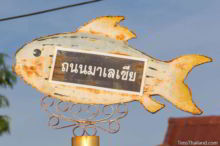
Kanchanaburi city
This fish is Jullien's golden carp (bplaa yisok), a popular food that is common in rivers here. Some say that if you don't eat it, you didn't really visit Kanchanaburi.
This fish is Jullien's golden carp (bplaa yisok), a popular food that is common in rivers here. Some say that if you don't eat it, you didn't really visit Kanchanaburi.
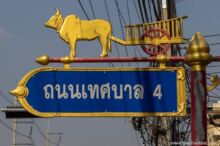
Ban Nong Khao, Kanchanaburi province
This town has adopted the oxcart as its symbol to honor the people’s agricultural past.
This town has adopted the oxcart as its symbol to honor the people’s agricultural past.
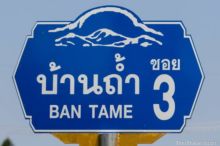
Ban Tham, Kanchanaburi province
The popular Wat Ban Tham temple is in the mountains very near this village.
The popular Wat Ban Tham temple is in the mountains very near this village.
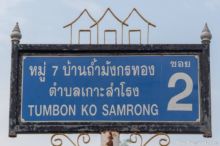
Ko Samrong, Kanchanaburi province
This village was settled by three Vietnamese families, represented by these houses.
This village was settled by three Vietnamese families, represented by these houses.
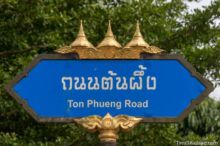
Sangkhlaburi, Kanchanaburi province
Three Pagodas Pass is a famous, historically important border crossing to Burma in the north of the province.
Three Pagodas Pass is a famous, historically important border crossing to Burma in the north of the province.
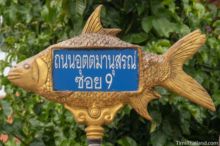
Sangkhlaburi, Kanchanaburi province
This fish is Jullien's golden carp (bplaa yisok), a common fish and popular food in the province. Some say that if you don't eat it, you didn't really visit Kanchanaburi.
This fish is Jullien's golden carp (bplaa yisok), a common fish and popular food in the province. Some say that if you don't eat it, you didn't really visit Kanchanaburi.
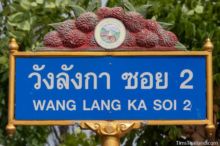
Tha Kha-nun, Kanchanaburi province
The "Thong Pha Phum Rambutan," which has a small size and sweet taste, grows in this area.
The "Thong Pha Phum Rambutan," which has a small size and sweet taste, grows in this area.
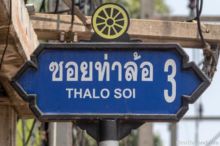
Tha Lo, Kanchanaburi province
The wheel is part of the symbol for the Army Transportation Department Training Center located here.
The wheel is part of the symbol for the Army Transportation Department Training Center located here.
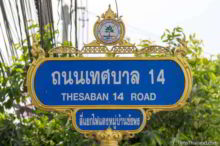
Tha Maka, Kanchanaburi province
The top of the sign has the Bridge Over the River Kwai, though it's not in this town.
The top of the sign has the Bridge Over the River Kwai, though it's not in this town.
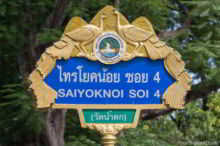
Tha Sao, Kanchanaburi province
Sai Yok Noi Waterfall is a very popular tourist destination. They chose peacocks because they look better on a sign than a waterfall.
Sai Yok Noi Waterfall is a very popular tourist destination. They chose peacocks because they look better on a sign than a waterfall.
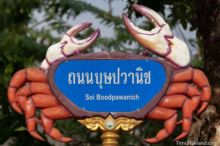
Thong Phu Phum, Kanchanaburi province
The rare Regal Crab (Thaiphusa sirikit), which has a blue body like the sign, is found in this area.
The rare Regal Crab (Thaiphusa sirikit), which has a blue body like the sign, is found in this area.
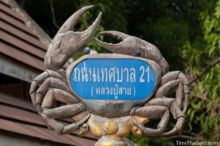
Thong Phu Phum, Kanchanaburi province
The rare Regal Crab (Thaiphusa sirikit), which has a blue body like the sign, is found in this area.
The rare Regal Crab (Thaiphusa sirikit), which has a blue body like the sign, is found in this area.
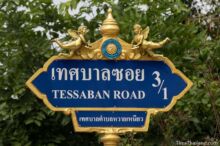
Wai Nieo, Kanchanaburi province
There is no connection between Cupid and Wai Nieo, but at one point in the past an influential local person decided it would be fun to have him on the street signs, and so it was done.
There is no connection between Cupid and Wai Nieo, but at one point in the past an influential local person decided it would be fun to have him on the street signs, and so it was done.
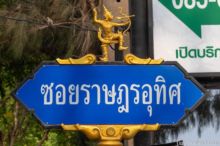
Lopburi city
This is the god Rama shooting an arrow. According to the Ramakien folktale, Lopburi was built where the arrow fell and was given as a gift to the monkey god Hanuman.
This is the god Rama shooting an arrow. According to the Ramakien folktale, Lopburi was built where the arrow fell and was given as a gift to the monkey god Hanuman.
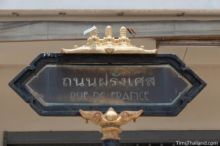
Lopburi city
This is Prang Sam Yot Khmer ruin, which lies in the heart of the city, with added Thai and French flags in honor of this being France Street.
This is Prang Sam Yot Khmer ruin, which lies in the heart of the city, with added Thai and French flags in honor of this being France Street.

Khao Sam Yot, Lopburi province
This "Three-Peaked-Mountain" sits at the east end of this sub-district.
This "Three-Peaked-Mountain" sits at the east end of this sub-district.
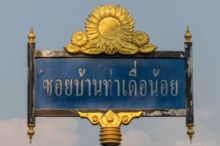
Khok Toom, Lopburi province
This is a popular tourist destination for its photogenic sunflower fields.
This is a popular tourist destination for its photogenic sunflower fields.
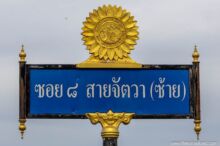
Khok Toom, Lopburi province
This is a popular tourist destination for its photogenic sunflower fields.
This is a popular tourist destination for its photogenic sunflower fields.
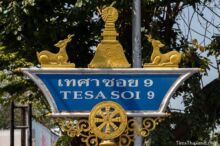
Nakhon Pathom city
This is the famous Phra Pathom Chedi. The dharma wheel and deer are symbols of Buddhism.
This is the famous Phra Pathom Chedi. The dharma wheel and deer are symbols of Buddhism.
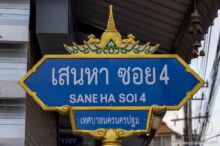
Nakhon Pathom city
This is the famous Phra Pathom Chedi. The dharma wheel and lotus are symbols of Buddhism.
This is the famous Phra Pathom Chedi. The dharma wheel and lotus are symbols of Buddhism.
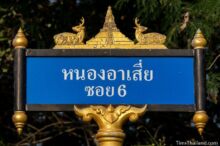
Phra Prathon, Nakhon Pathom province
This is the famous Phra Pathom Chedi. Deer are symbols of Buddhism.
This is the famous Phra Pathom Chedi. Deer are symbols of Buddhism.
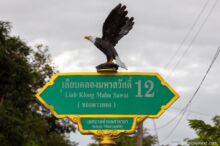
Salaya, Nakhon Pathom province
“Black Eagle” was the nickname of a former muay thai boxer; the father of the mayor who commissioned these signs.
“Black Eagle” was the nickname of a former muay thai boxer; the father of the mayor who commissioned these signs.
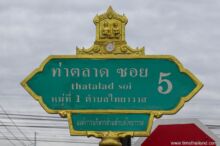
Thaiyawat, Nakhon Pathom province
The elderly couple represent the area’s Mon ancestors who settled here some 900 years ago.
The elderly couple represent the area’s Mon ancestors who settled here some 900 years ago.
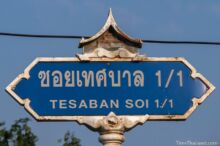
Thammasala, Nakhon Pathom province
A sala was chosen as the symbol of this tambon because its name means "Dharma Sala." Sitting in a sala is pleasant and relaxing and following dharma provides peace and tranquility in your life.
A sala was chosen as the symbol of this tambon because its name means "Dharma Sala." Sitting in a sala is pleasant and relaxing and following dharma provides peace and tranquility in your life.
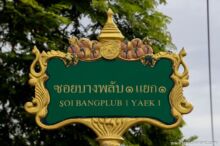
Bang Phlap, Nonthaburi province
These are persimmon, chosen because Tambon Bang Phlap has a lot of fruit orchards. The stupa on top represents three old stupas in the area of Wat Salikho Phirataram.
These are persimmon, chosen because Tambon Bang Phlap has a lot of fruit orchards. The stupa on top represents three old stupas in the area of Wat Salikho Phirataram.
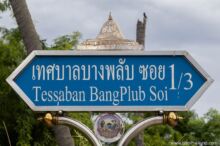
Bang Phlap, Nonthaburi province
This stupa represents three old stupas in the area of Wat Salikho Phirataram.
This stupa represents three old stupas in the area of Wat Salikho Phirataram.
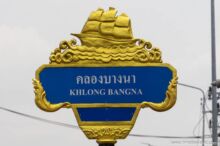
Kra Chang, Pathum Thani province
Tambon Kra Chang chose a boat as its municipal symbol because the Mon community here has an important merit making tradition using boats (though not sailboats) festooned with flags during the annual kathin festival.
Tambon Kra Chang chose a boat as its municipal symbol because the Mon community here has an important merit making tradition using boats (though not sailboats) festooned with flags during the annual kathin festival.
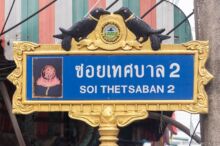
Lam Luk Ka, Pathum Thani province
The crow is a namesake and symbol of this district because there is a stream with three branches; kind of like a crow’s foot. The rattan sepak takraw ball picture is used because the area is well-known for weaving them.
The crow is a namesake and symbol of this district because there is a stream with three branches; kind of like a crow’s foot. The rattan sepak takraw ball picture is used because the area is well-known for weaving them.
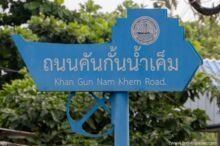
Ban Laem, Phetchaburi province
Ban Laem lies near the mouth of the Phetchaburi River. It was once an important international trading port and today has a large fishing industry.
Ban Laem lies near the mouth of the Phetchaburi River. It was once an important international trading port and today has a large fishing industry.
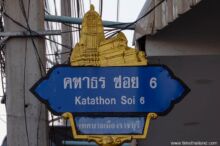
Ratchaburi city
Phra Prang Wat Mahathat stupa, originally built by the Khmer empire, is one of the province’s holiest sites.
Phra Prang Wat Mahathat stupa, originally built by the Khmer empire, is one of the province’s holiest sites.
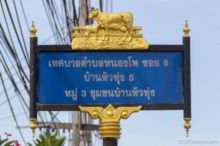
Ban Nong Pho, Ratchaburi province
There is a very large dairy farm here and their Nom Nong Pho is a famous brand of milk.
There is a very large dairy farm here and their Nom Nong Pho is a famous brand of milk.
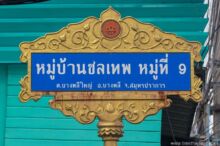
Bang Phli Yai, Samut Prakan province
The lotus flowers represent the annual Rob Bua (“Lotus Receiving”) Festival held on the canal during Ok Phansa.
The lotus flowers represent the annual Rob Bua (“Lotus Receiving”) Festival held on the canal during Ok Phansa.

Laem Fa Pha, Samut Prakan province
Laem fa pha means lightning bolt, and in this famous folkloric fight scene, Ramasun throws his axe at Mekhala, goddess of the sea, and creates lightning.
Laem fa pha means lightning bolt, and in this famous folkloric fight scene, Ramasun throws his axe at Mekhala, goddess of the sea, and creates lightning.
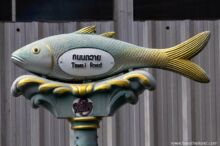
Samut Sakhon city
Chin Huay is a large Thai company selling a variety of food products. It began in Samut Sakhon, selling canned sardines.
Chin Huay is a large Thai company selling a variety of food products. It began in Samut Sakhon, selling canned sardines.
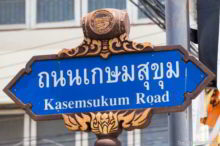
Samut Songkhram city
The old name of the province was Mae Khlong and though the meaning of the name is lost to history, the word khlong also means drum, so it was adopted as a provincial symbol.
The old name of the province was Mae Khlong and though the meaning of the name is lost to history, the word khlong also means drum, so it was adopted as a provincial symbol.
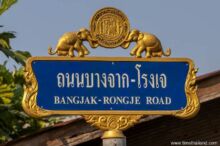
Amphawa, Samut Songkhram province
This sign harkens back to the past when this area was known as bang chang, meaning an area with elephants.
This sign harkens back to the past when this area was known as bang chang, meaning an area with elephants.
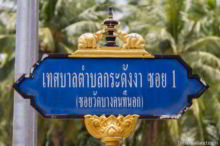
Ban Kradangnga, Samut Songkhram province
These elephants are holding ylang-ylang flowers (a symbol of the subdistrict) and bowing down before a fancy water jug because King Rama 5 once came here and left his behind.
These elephants are holding ylang-ylang flowers (a symbol of the subdistrict) and bowing down before a fancy water jug because King Rama 5 once came here and left his behind.
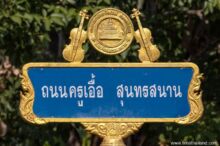
Muang Mai, Samut Songkhram province
The violins are to honor Eua Sunthornsanan, one of Thailand’s most famous singers and composers, who lived and went to school here.
The violins are to honor Eua Sunthornsanan, one of Thailand’s most famous singers and composers, who lived and went to school here.
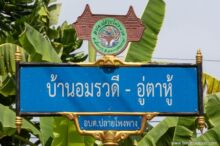
Plai Phongphang, Samut Songkhram province
Nobody at the township office could tell me why a traditional Thai house was used on the street sign; the people who worked there when the signs were installed have since retired.
Nobody at the township office could tell me why a traditional Thai house was used on the street sign; the people who worked there when the signs were installed have since retired.
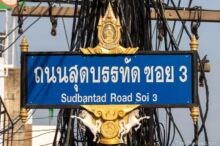
Saraburi city
Saraburi has been an important military town for many centuries, and it's home to a large cavalry army base.
Saraburi has been an important military town for many centuries, and it's home to a large cavalry army base.
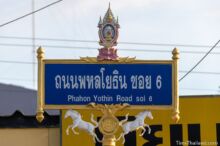
Saraburi city
Saraburi has been an important military town for many centuries, and it's home to a large cavalry army base.
Saraburi has been an important military town for many centuries, and it's home to a large cavalry army base.
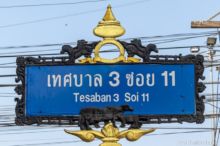
Muak Lek, Saraburi province
The cows and cowboys are because this part of Saraburi has many dairy farms.
The cows and cowboys are because this part of Saraburi has many dairy farms.
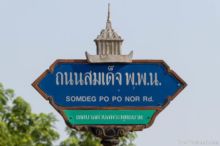
Phra Phuthabat, Saraburi province
This is the mondap that houses the very holy Buddha footprint at Wat Phra Phutthabat.
This is the mondap that houses the very holy Buddha footprint at Wat Phra Phutthabat.
Eastern Thailand
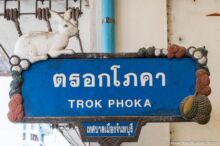
Chanthaburi city
Chanthaburi means “Moon City,” and the rabbit has been adopted as the provincial symbol because of a famous legend about a rabbit on the moon. Also, Chanthaburi is one of the main fruit-producing provinces in Thailand, hence the mangosteen, palm fruit, and durian.
Chanthaburi means “Moon City,” and the rabbit has been adopted as the provincial symbol because of a famous legend about a rabbit on the moon. Also, Chanthaburi is one of the main fruit-producing provinces in Thailand, hence the mangosteen, palm fruit, and durian.
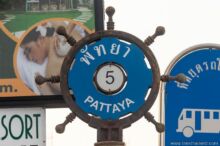
Pattaya, Chonburi province
The pilot wheel hearkens back to when this was just a quiet fishing village.
The pilot wheel hearkens back to when this was just a quiet fishing village.
Northeastern Thailand
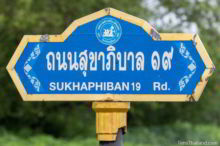
Non Din Daeng, Buriram province
The government seal at the top shows the Rao Su ("We Fight") Memorial, which commemorates people who died fighting communists who were trying to sabotage construction of the highway here.
The government seal at the top shows the Rao Su ("We Fight") Memorial, which commemorates people who died fighting communists who were trying to sabotage construction of the highway here.
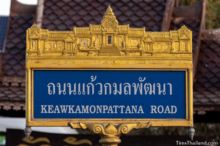
Tambon Charoen Suk, Buriram province
This is the front view of Prasat Phanom Rung Khmer ruin, which is nearby.
This is the front view of Prasat Phanom Rung Khmer ruin, which is nearby.
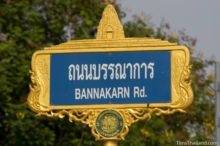
Chaiyaphum city
The top is Prang Ku, a Khmer ruin on the edge of the city, and there are Siam tulips, one of the province's main tourist attractions, on the sides.
The top is Prang Ku, a Khmer ruin on the edge of the city, and there are Siam tulips, one of the province's main tourist attractions, on the sides.
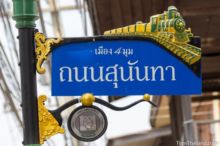
Chutturat, Chaiyaphum province
This small town lies along the rail line between Bangkok and Nong Khai.
This small town lies along the rail line between Bangkok and Nong Khai.
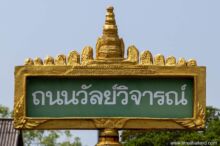
Nong Paen, Kalasin province
This tambon is home to Phrathat Ya Khu stupa, the centerpiece of Maeung Fa Daet Song Yang, a Dvaravati-era city.
This tambon is home to Phrathat Ya Khu stupa, the centerpiece of Maeung Fa Daet Song Yang, a Dvaravati-era city.
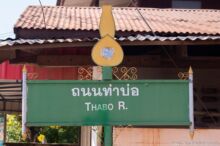
Tha Khantho, Kalasin province
This district was named after an old type of jug, called a khantho in Thai, because the land lays between two rivers and once had that shape.
This district was named after an old type of jug, called a khantho in Thai, because the land lays between two rivers and once had that shape.
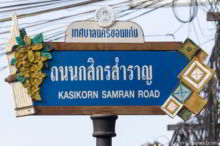
Khon Kaen city
The kaen musical instrument and decorative squares are symbols of Isan culture. Dok koon is the provincial flower.
The kaen musical instrument and decorative squares are symbols of Isan culture. Dok koon is the provincial flower.
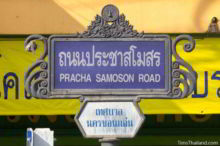
Khon Kaen city
The official city seal on the top has Phra That Kham Kaen, one of the province's most revered stupas.
The official city seal on the top has Phra That Kham Kaen, one of the province's most revered stupas.
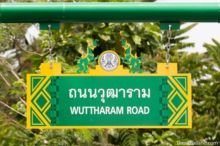
Khon Kaen city
These street signs have two Isan symbols: kochasi from the Sin Sai legend and diamond patterns used as temple decorations.
These street signs have two Isan symbols: kochasi from the Sin Sai legend and diamond patterns used as temple decorations.
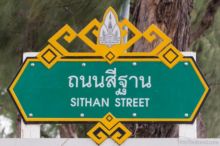
Khon Kaen city
These street signs are found at Khon Kaen University. It has several patterns used in silk weaving.
These street signs are found at Khon Kaen University. It has several patterns used in silk weaving.
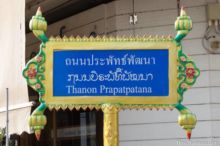
Ban Phai, Khon Kaen province
A person at city hall said these are supposed to be lotuses, but neither lotus flowers or bulbs look like this, so I don't know what the real story is.
A person at city hall said these are supposed to be lotuses, but neither lotus flowers or bulbs look like this, so I don't know what the real story is.

Kranuan, Khon Kaen province
Kranuan has a large rocket festival, and the rockets are decorated with naga like this during a parade.
Kranuan has a large rocket festival, and the rockets are decorated with naga like this during a parade.
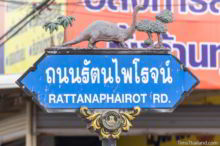
Phu Wiang, Khon Kaen province
Phu Wiang National Park was the first place dinosaur fossils were found in Thailand.
Phu Wiang National Park was the first place dinosaur fossils were found in Thailand.
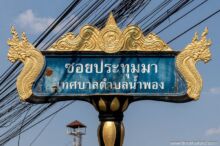
Nam Phong, Khon Kaen province
This district is named after the Nam Phong River, so it’s logical to have the water-related naga as a symbol.
This district is named after the Nam Phong River, so it’s logical to have the water-related naga as a symbol.
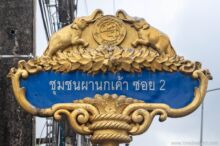
Tambon Phu Kradueng, Loei province
Phu Kradeung sub-district is most famous for the national park that shares its name, which has many elephants.
Phu Kradeung sub-district is most famous for the national park that shares its name, which has many elephants.
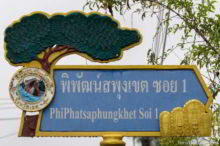
Wang Saphung, Loei province
The tree is Tetrameles nudiflora, which in Thai is a sapung tree, and because there are many of them here, the town took it for its name. In the lower right are Dvaravati era bai sema sacred boundary stones found at Wat Phatthasimaram.
The tree is Tetrameles nudiflora, which in Thai is a sapung tree, and because there are many of them here, the town took it for its name. In the lower right are Dvaravati era bai sema sacred boundary stones found at Wat Phatthasimaram.
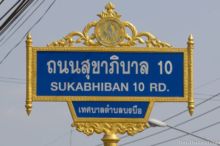
Borabue, Maha Sarakham province
The circle is the official city seal, which has a lotus and a dharma wheel.
The circle is the official city seal, which has a lotus and a dharma wheel.
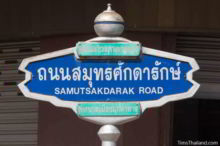
Mukdahan city
The ball represents the city's number one tourist attraction, Ho Kaew Mukdahan, a 65m-tall museum and observation tower. Though the real one has a much smaller pole on top.
The ball represents the city's number one tourist attraction, Ho Kaew Mukdahan, a 65m-tall museum and observation tower. Though the real one has a much smaller pole on top.
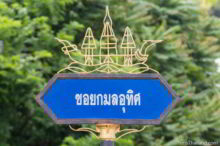
Nakhon Phanom city
Nakhon Phanom has Thailand's biggest "fire boat" parade at the end of the Buddhist Rains Retreat. This is what the boats look like.
Nakhon Phanom has Thailand's biggest "fire boat" parade at the end of the Buddhist Rains Retreat. This is what the boats look like.
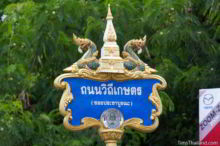
That Phanom, Nakhon Phanom province
That Phanom is home to one of the holiest stupas in Thailand and Laos.
That Phanom is home to one of the holiest stupas in Thailand and Laos.
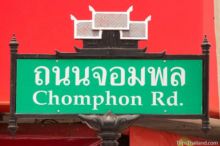
Nakhon Ratchasima city
This is Pratu Chomphon city gate, the only original part of the old fortifications still standing.
This is Pratu Chomphon city gate, the only original part of the old fortifications still standing.
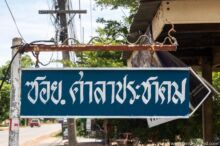
Ban Wang Nam Khao, Nong Bua Lamphu province
As far as I can determine, this naga is just some low-cost decorative flair and doesn’t represent anything specific to the village.
As far as I can determine, this naga is just some low-cost decorative flair and doesn’t represent anything specific to the village.
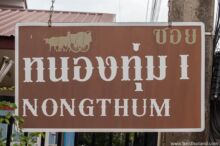
Tambon Ban Kho, Nong Bua Lamphu province
An ox cart was chose because a lot of cattle are raised in this area.
An ox cart was chose because a lot of cattle are raised in this area.
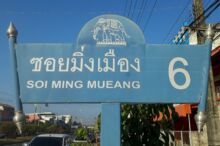
Si Chiang Mai, Nong Khai province
Si Chiang Mai uses an elephant as a symbol because in the past there was an elephant stockade here for keeping the royal elephants.
Si Chiang Mai uses an elephant as a symbol because in the past there was an elephant stockade here for keeping the royal elephants.
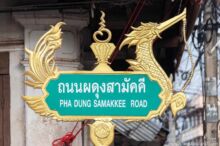
Tha Bo, Nong Khai province
The "bird" is a representation of Suphannahong ("The Golden Swan"), the largest of Thailand's royal barges. It is used as a symbol of Tha Bo to commemorate a visit from King Rama 9 in 1955.
The "bird" is a representation of Suphannahong ("The Golden Swan"), the largest of Thailand's royal barges. It is used as a symbol of Tha Bo to commemorate a visit from King Rama 9 in 1955.
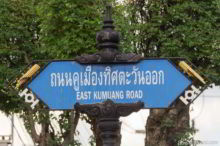
Roi Et city
'Roi Et' means 101 in Thai, and many musical instruments, including wot (circular pan flute) are made in the province.
'Roi Et' means 101 in Thai, and many musical instruments, including wot (circular pan flute) are made in the province.
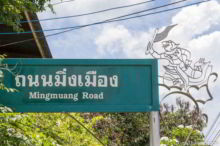
Ban Niwet, Roi Et province
This village's former name was Ban Bong Ling, "Monkey Salt Lick Village" because there used to be a troop of monkeys that hung around a salt lick near the village.
This village's former name was Ban Bong Ling, "Monkey Salt Lick Village" because there used to be a troop of monkeys that hung around a salt lick near the village.
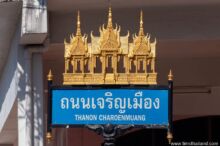
Sakon Nakhon city
This is what the parade floats look like during the city's Wax Castle Festival at the end of Ok Phansa.
This is what the parade floats look like during the city's Wax Castle Festival at the end of Ok Phansa.
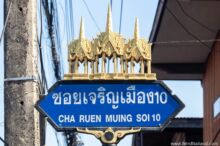
Sakon Nakhon city
This is what the parade floats look like during the city's Wax Castle Festival at the end of Ok Phansa.
This is what the parade floats look like during the city's Wax Castle Festival at the end of Ok Phansa.
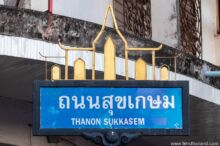
Sakon Nakhon city
This design represents Phra That Choeng Chum, Sakon Nakhon city's holiest site and principal tourist attraction.
This design represents Phra That Choeng Chum, Sakon Nakhon city's holiest site and principal tourist attraction.
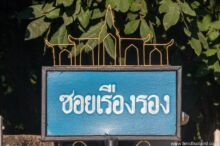
Sakon Nakhon city
This design represents Phra That Choeng Chum, Sakon Nakhon city's holiest site and principal tourist attraction.
This design represents Phra That Choeng Chum, Sakon Nakhon city's holiest site and principal tourist attraction.
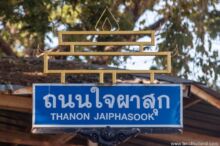
Sakon Nakhon city
This design represents Phra That Choeng Chum, Sakon Nakhon city's holiest site and principal tourist attraction.
This design represents Phra That Choeng Chum, Sakon Nakhon city's holiest site and principal tourist attraction.
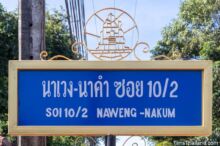
Tambon That Naweng, Sakon Nakhon province
The noticeably non-symmetrical stupa is Phra That Narai Jeng Weng, the source of the Tambon's name – Naweng being a shortened form of Na(rai Jeng) Weng.
The noticeably non-symmetrical stupa is Phra That Narai Jeng Weng, the source of the Tambon's name – Naweng being a shortened form of Na(rai Jeng) Weng.
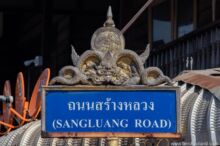
Waritchaphum, Sakon Nakhon province
This kala design is inspired by, though not a direct copy of, the kala on the pediment of the city's important Jao Pu Mahesak Shrine.
This kala design is inspired by, though not a direct copy of, the kala on the pediment of the city's important Jao Pu Mahesak Shrine.
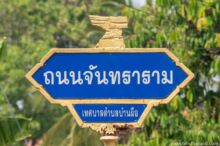
Ban Phue, Udon Thani province
This is Ho Nang Usa, an iconic rock formation in the nearby Phu Phrabat Historical Park.
This is Ho Nang Usa, an iconic rock formation in the nearby Phu Phrabat Historical Park.
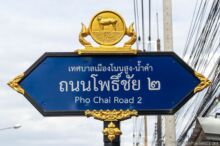
Nonsung-Namkham, Udon Thani province
The founder of this town was a powerful man and he chose the symbol of a tiger standing on a tall wall as its symbol to provide strength for the town.
The founder of this town was a powerful man and he chose the symbol of a tiger standing on a tall wall as its symbol to provide strength for the town.
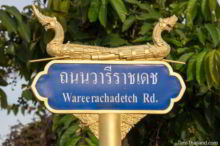
Yasothon city
Yasothon has the biggest rocket festival in Thailand, and the rockets are decorated like this when they are in the parade.
Yasothon has the biggest rocket festival in Thailand, and the rockets are decorated like this when they are in the parade.
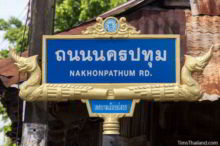
Yasothon city
Yasothon has the biggest rocket festival in Thailand, and the rockets are decorated like this when they are in the parade.
Yasothon has the biggest rocket festival in Thailand, and the rockets are decorated like this when they are in the parade.
Northern Thailand
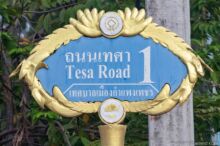
Kamphaeng Phet city
Kamphaeng Phet is famous for its bananas; particularly the small, sweet gluai kai (“egg banana”).
Kamphaeng Phet is famous for its bananas; particularly the small, sweet gluai kai (“egg banana”).
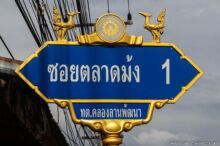
Khlong Lan, Kamphaeng Phet province
The mythical hongsa atop these street signs are purely decorative and have no specific connection to this town, although they are particularly popular throughout Kamphaeng Phet province due to some ancient ones found here.
The mythical hongsa atop these street signs are purely decorative and have no specific connection to this town, although they are particularly popular throughout Kamphaeng Phet province due to some ancient ones found here.
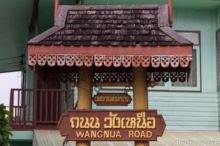
Lampang city
This is in the style of a han-nam, the traditional Lanna roofed stand used for keeping water pots to offer refreshment to visitors.
This is in the style of a han-nam, the traditional Lanna roofed stand used for keeping water pots to offer refreshment to visitors.
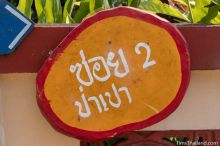
Ban Tha Pa Pao, Lamphun province
There's no story or symbolism, I just like that it's made from a slice of tree trunk.
There's no story or symbolism, I just like that it's made from a slice of tree trunk.
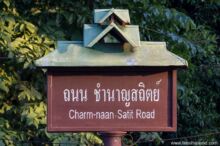
Mae Hong Son city
This is a Shan-style type of roof construction called sawng kaw sahm chai, “two necks, three edges.”
This is a Shan-style type of roof construction called sawng kaw sahm chai, “two necks, three edges.”
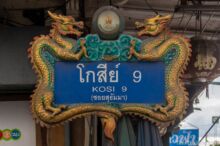
Nakhon Sawan city
Nakhon Sawan has adopted the dragon as its symbol due to its large Chinese population.
Nakhon Sawan has adopted the dragon as its symbol due to its large Chinese population.
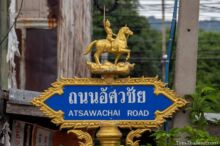
Ban Takhli, Nakhon Sawan province
The name Takhli is derived from dee-klee, a sport similar to polo played by Phra Sang (the man on the sign) and the god Indra in the musical Sang Thong written by King Rama 2.
The name Takhli is derived from dee-klee, a sport similar to polo played by Phra Sang (the man on the sign) and the god Indra in the musical Sang Thong written by King Rama 2.
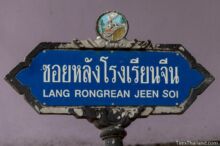
Chong Khae, Nakhon Sawan province
Long ago, when the railroad was being constructed, there were many large trumpet trees (ton khae na) here.
Long ago, when the railroad was being constructed, there were many large trumpet trees (ton khae na) here.
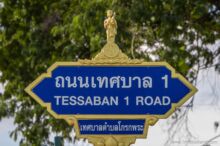
Krok Phra, Nakhon Sawan province
Krok is high land on a river bank and Phra is monk. The particular monk chosen for the street signs is Phra Siwali, one of the Buddha’s top disciples.
Krok is high land on a river bank and Phra is monk. The particular monk chosen for the street signs is Phra Siwali, one of the Buddha’s top disciples.
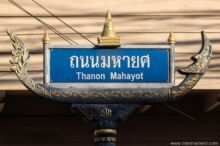
Nan city
At the bottom of the sign is a traditional Nan long boat – long boat racing is very popular here – and the stupa on top is Phra That Chae Haeng.
At the bottom of the sign is a traditional Nan long boat – long boat racing is very popular here – and the stupa on top is Phra That Chae Haeng.
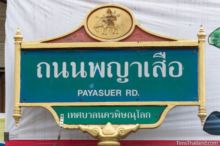
Phitsanulok city
King Naresuan, shown riding his war elephant, ruled Ayutthaya, but was born in Phitsanulok.
King Naresuan, shown riding his war elephant, ruled Ayutthaya, but was born in Phitsanulok.
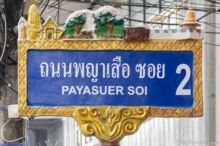
Phitsanulok city
Has five icons of Phitsanulok province. 1) Wat Phra Si Ratana Mahathat (home to the famous Chinnarat Buddha, but the Buddha on this sign is the large Phra Attharot Buddha). 2) Nature, represented by the waterfall. 3) Houseboats on the Nan River. 4) Native son King Naresuan riding his war elephant. (The elephants are often broken.) 5) The ancient, and long ago destroyed, "Naresuan Hat Fortress." When replica sections of the old city walls were built, hat-shaped roofs were included over the towers in honor of this fort.
Has five icons of Phitsanulok province. 1) Wat Phra Si Ratana Mahathat (home to the famous Chinnarat Buddha, but the Buddha on this sign is the large Phra Attharot Buddha). 2) Nature, represented by the waterfall. 3) Houseboats on the Nan River. 4) Native son King Naresuan riding his war elephant. (The elephants are often broken.) 5) The ancient, and long ago destroyed, "Naresuan Hat Fortress." When replica sections of the old city walls were built, hat-shaped roofs were included over the towers in honor of this fort.
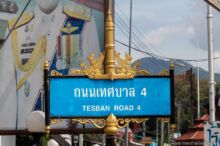
Cho Hae, Phrae province
Nobody in the district office could tell us what is atop this street sign, but it is probably a candle since Phrae has a large candle parade during Khao Phansa.
Nobody in the district office could tell us what is atop this street sign, but it is probably a candle since Phrae has a large candle parade during Khao Phansa.
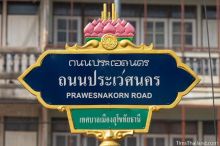
Sukhothai city
The lotus shape on top is a float for the Loy Kratong festival, which is a very big event in Sukhothai.
The lotus shape on top is a float for the Loy Kratong festival, which is a very big event in Sukhothai.
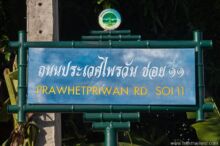
Umphang, Tak province
In the local language, Umphang is a type of container (กระบอกไม้ไผ่) made of bamboo.
In the local language, Umphang is a type of container (กระบอกไม้ไผ่) made of bamboo.
Southern Thailand
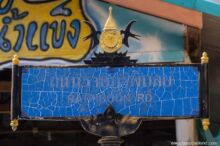
Pak Tako, Chumphon province
The birds are swiftlets, and their nests are used for making bird nest soup, an expensive Chinese delicacy. This region has many caves where the nests are collected, and these natural nests are considered superior to farmed nests.
The birds are swiftlets, and their nests are used for making bird nest soup, an expensive Chinese delicacy. This region has many caves where the nests are collected, and these natural nests are considered superior to farmed nests.
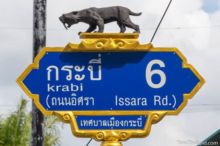
Krabi city
This is a smilodon, a type of saber tooth tiger. Theirs are some of the many fossils of ancient animals found in the Krabi area.
This is a smilodon, a type of saber tooth tiger. Theirs are some of the many fossils of ancient animals found in the Krabi area.
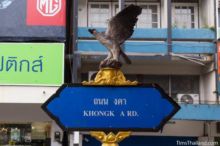
Krabi city
This is a white-bellied sea eagle (nok-awk). These birds are rare in Thailand, though several nest in the Krabi area.
This is a white-bellied sea eagle (nok-awk). These birds are rare in Thailand, though several nest in the Krabi area.

Krabi city
An elephant holding a sword is the symbol of the city. In the past, Krabi was noted for its large elephant population, and the word krabi means sword, and this is probably (there are other theories) where the name of the province came from.
An elephant holding a sword is the symbol of the city. In the past, Krabi was noted for its large elephant population, and the word krabi means sword, and this is probably (there are other theories) where the name of the province came from.
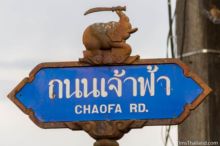
Krabi city
An elephant holding a sword is the symbol of the city. In the past, Krabi was noted for its large elephant population, and the word krabi means sword, and this is probably (there are other theories) where the name of the province came from.
An elephant holding a sword is the symbol of the city. In the past, Krabi was noted for its large elephant population, and the word krabi means sword, and this is probably (there are other theories) where the name of the province came from.

Ao Nang, Krabi province
These are sailfish, a popular sportfishing prey. The design is similar to a large sculpture along the waterfront.
These are sailfish, a popular sportfishing prey. The design is similar to a large sculpture along the waterfront.
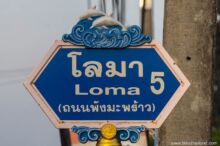
Khanom, Nakhon Si Thammarat province
This area is renowned for the 60-or-so pink dolphins who live along the coast here and are routinely spotted during boat tours.
This area is renowned for the 60-or-so pink dolphins who live along the coast here and are routinely spotted during boat tours.
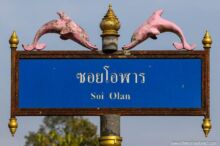
Khanom, Nakhon Si Thammarat province
This area is renowned for the 60-or-so pink dolphins who live along the coast here and are routinely spotted during boat tours.
This area is renowned for the 60-or-so pink dolphins who live along the coast here and are routinely spotted during boat tours.
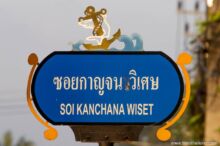
Pak Nakhon, Nakhon Si Thammarat province
The anchor and shark design is on the tambon’s official seal. It uses a nautical theme because, long ago, people traveling to Nakhon Si Thammarat, once a very important city, would arrive by ship here before traveling up the river.
The anchor and shark design is on the tambon’s official seal. It uses a nautical theme because, long ago, people traveling to Nakhon Si Thammarat, once a very important city, would arrive by ship here before traveling up the river.
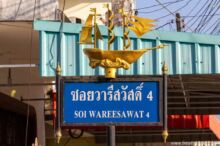
Pak Phanang, Nakhon Si Thammarat province
As a naturally protected port at the mouth of the Pak Phanang River, this was once a very prosperous port city receiving many Chinese junk trading ships.
As a naturally protected port at the mouth of the Pak Phanang River, this was once a very prosperous port city receiving many Chinese junk trading ships.
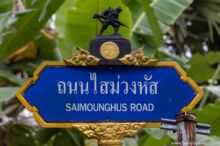
Pak Phun, Nakhon Si Thammarat province
This is a copy of the Weerathai (“Thai Heroes”) Monument at Fort Wachirawut army base that commemorates the soldiers who died resisting the Japanese invasion of Thailand during World War 2.
This is a copy of the Weerathai (“Thai Heroes”) Monument at Fort Wachirawut army base that commemorates the soldiers who died resisting the Japanese invasion of Thailand during World War 2.
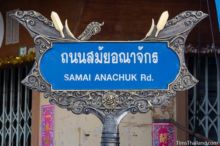
Narathiwat city
An artistic representation of a traditional korlae fishing boat, typical of far southern Thailand.
An artistic representation of a traditional korlae fishing boat, typical of far southern Thailand.
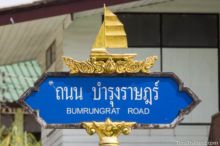
Tak Bai, Narathiwat province
The sailboat represents this region's connection to the sea in commerce and fishing, and connections to faraway places.
The sailboat represents this region's connection to the sea in commerce and fishing, and connections to faraway places.
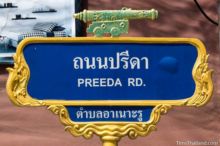
Pattani city
This is the 17th-century Phaya Tani cannon, the largest ever cast in Thailand. It was hauled off to Bangkok after the Thais defeated the sultanate and destroyed the city in 1786. It's now on display in front of the Defense Ministry and the government's refusal to return it to Pattani is a taken a serious affront by many locals.
This is the 17th-century Phaya Tani cannon, the largest ever cast in Thailand. It was hauled off to Bangkok after the Thais defeated the sultanate and destroyed the city in 1786. It's now on display in front of the Defense Ministry and the government's refusal to return it to Pattani is a taken a serious affront by many locals.

Phang Nga city
The symbol of an elephant holding a lotus in its trunk comes from Khao Chang mountain on the southwest side of the city, which has the shape of a crouching elephant.
The symbol of an elephant holding a lotus in its trunk comes from Khao Chang mountain on the southwest side of the city, which has the shape of a crouching elephant.
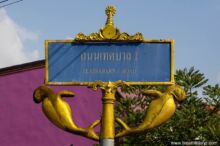
Pak Phayun, Phatthalung province
Phayun means dugong, and long ago there were many of them living here.
Phayun means dugong, and long ago there were many of them living here.
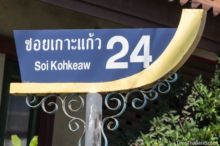
Koh Kaew, Phuket province
In the past, many people here worked in fishing, and this sign artistically represents the front of a fishing boat.
In the past, many people here worked in fishing, and this sign artistically represents the front of a fishing boat.
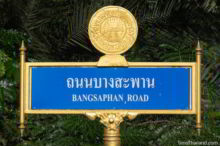
Bang Saphan Yai, Prachuap Khiri Khan province
The big gold disk is the city's official seal, which features Wat Khao Bot temple.
The big gold disk is the city's official seal, which features Wat Khao Bot temple.
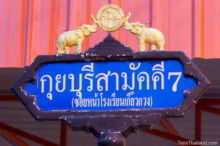
Kuiburi, Prachuap Khiri Khan province
Kuiburi National Park is one of the best places in Thailand to see wild elephants.
Kuiburi National Park is one of the best places in Thailand to see wild elephants.
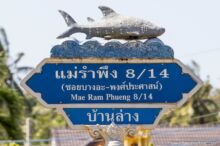
Mae Ram Phueng, Prachuap Khiri Khan province
This is one of the few areas in Thailand where whale sharks are regularly seen.
This is one of the few areas in Thailand where whale sharks are regularly seen.
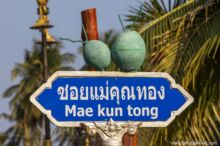
Thap Sakae, Prachuap Khiri Khan province
Thap Sakae coconuts are a hybrid variety known for their fragrant oil, making the milk popular for cooking here and beyond.
Thap Sakae coconuts are a hybrid variety known for their fragrant oil, making the milk popular for cooking here and beyond.
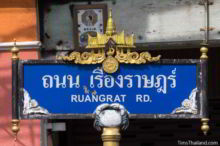
Ranong city
The top of the sign comes from the province's official seal. The building represents Ratana Rangsan Palace where King Rama 5 stayed in 1890 – the symbol in the middle of the building is the Thai numeral 5. At the bottom is a crab, since Ranong has hundreds of soft shell crab farms.
The top of the sign comes from the province's official seal. The building represents Ratana Rangsan Palace where King Rama 5 stayed in 1890 – the symbol in the middle of the building is the Thai numeral 5. At the bottom is a crab, since Ranong has hundreds of soft shell crab farms.

Ranong city
At the center of the design is a ship's wheel around the reclining Buddha from Wat Waree Banprot, one of the province's most important temples. The birds on the sides are hongsa, swan-like birds from the mythical Himmapan Forest. Nobody could tell me if the bell-shaped top represents anything or not. I thought maybe it was supposed to be a lighthouse, but was told that it was not this.
At the center of the design is a ship's wheel around the reclining Buddha from Wat Waree Banprot, one of the province's most important temples. The birds on the sides are hongsa, swan-like birds from the mythical Himmapan Forest. Nobody could tell me if the bell-shaped top represents anything or not. I thought maybe it was supposed to be a lighthouse, but was told that it was not this.
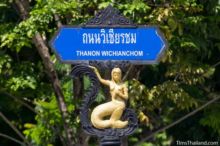
Songkhla city
A bronze mermaid statue was erected on Laem Samila Beach in 1966 and has since become the symbol of the city. The mermaid comes from the classic folktale Phra Apai Manee written by Sunthorn Phu, "The Shakespeare of Thailand."
A bronze mermaid statue was erected on Laem Samila Beach in 1966 and has since become the symbol of the city. The mermaid comes from the classic folktale Phra Apai Manee written by Sunthorn Phu, "The Shakespeare of Thailand."
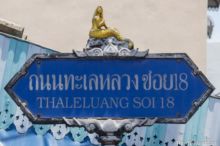
Songkhla city
A bronze mermaid statue was erected on Laem Samila Beach in 1966 and has since become the symbol of the city. The mermaid comes from the classic folktale Phra Apai Manee written by Sunthorn Phu, "The Shakespeare of Thailand."
A bronze mermaid statue was erected on Laem Samila Beach in 1966 and has since become the symbol of the city. The mermaid comes from the classic folktale Phra Apai Manee written by Sunthorn Phu, "The Shakespeare of Thailand."
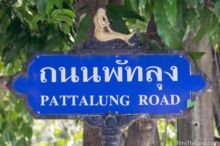
Songkhla city
A bronze mermaid statue was erected on Laem Samila Beach in 1966 and has since become the symbol of the city. The mermaid comes from the classic folktale Phra Apai Manee written by Sunthorn Phu, "The Shakespeare of Thailand."
A bronze mermaid statue was erected on Laem Samila Beach in 1966 and has since become the symbol of the city. The mermaid comes from the classic folktale Phra Apai Manee written by Sunthorn Phu, "The Shakespeare of Thailand."
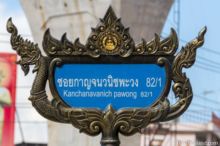
Phawong, Songkhla province
The naga design represents a parade float. Tambon Phawong often wins the phra ruea parade competition.
The naga design represents a parade float. Tambon Phawong often wins the phra ruea parade competition.

Tha Chang, Songkhla province
Tha Chang means Elephant Waterfront, and long ago mahouts brought their elephants here to bathe in the river.
Tha Chang means Elephant Waterfront, and long ago mahouts brought their elephants here to bathe in the river.
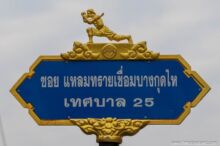
Phum Riang, Surat Thani province
The fighter represents the local version of Thai kickboxing, Muay Thai Chaiya.
The fighter represents the local version of Thai kickboxing, Muay Thai Chaiya.
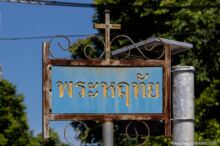
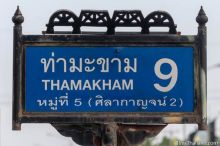
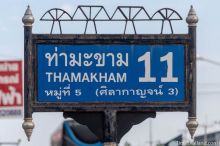
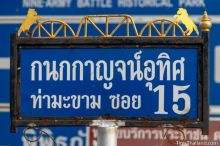
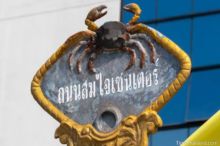
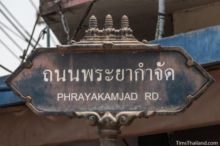
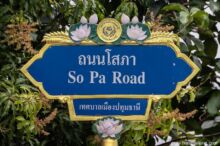
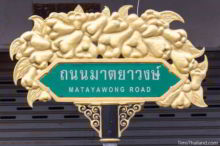
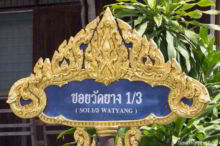
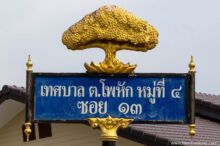
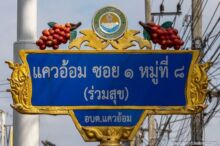

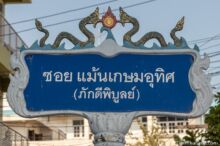
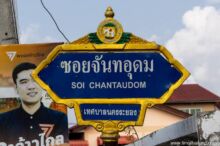
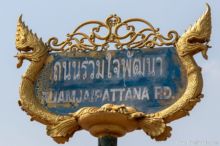
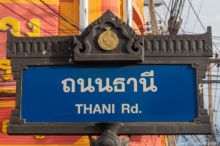
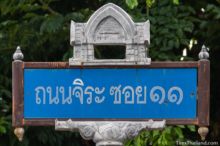
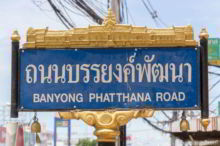
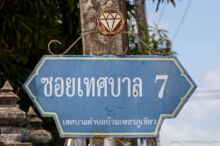
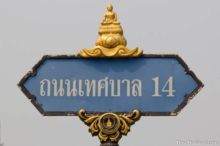
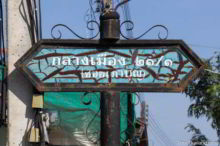
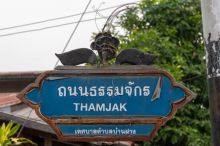
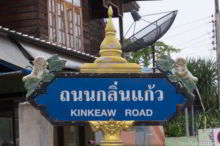
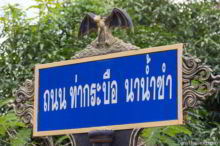
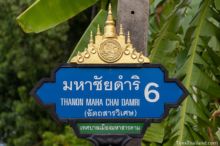
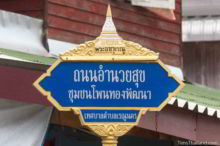
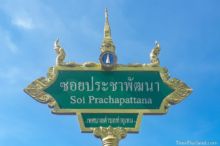
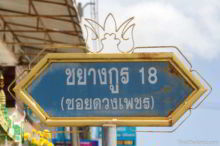

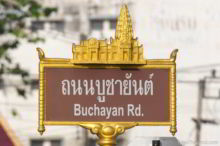
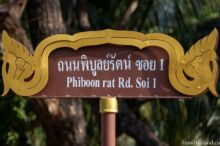
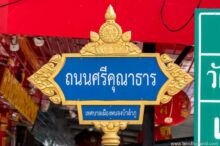
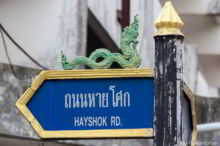
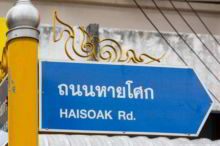
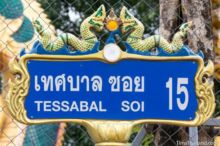
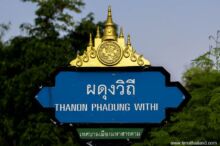
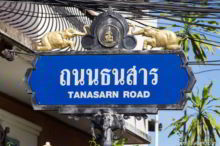
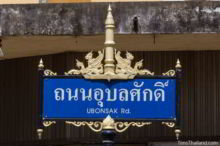
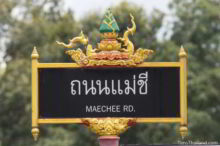
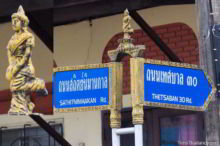
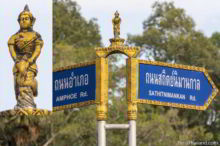
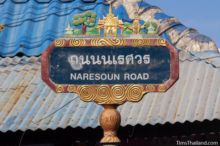
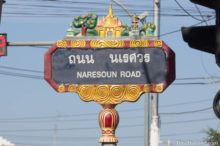
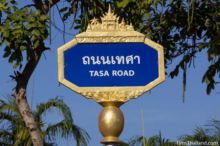
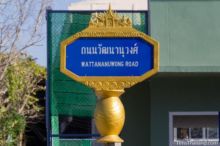
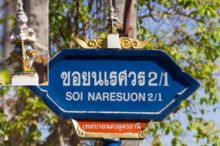
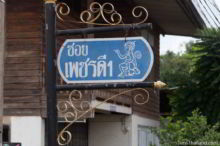
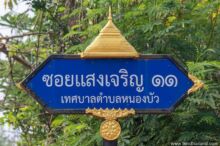
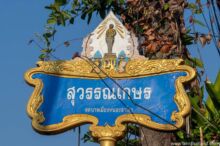
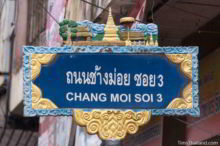
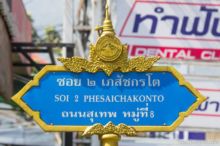

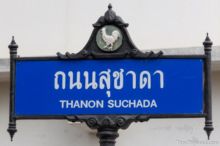
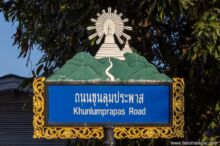
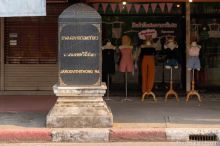
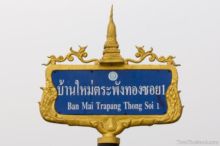
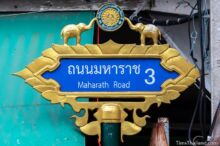
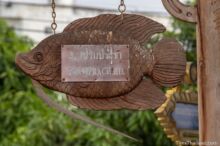

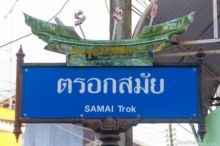
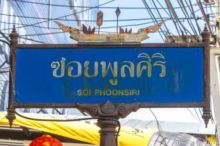
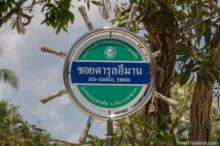
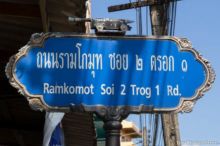
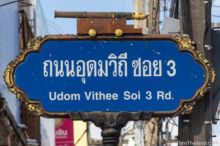

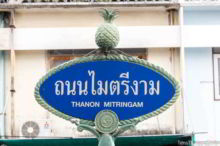
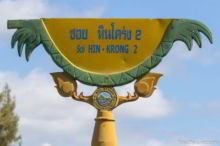
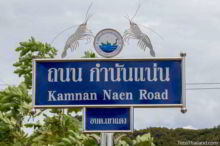
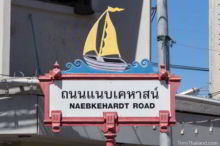
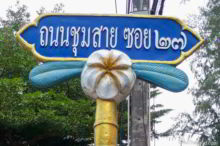
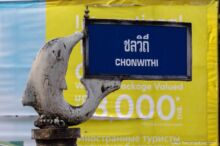
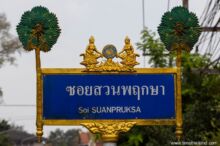
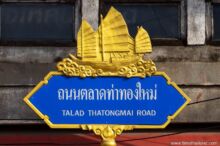
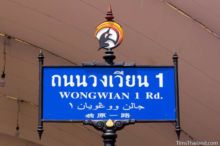
4 thoughts on “Thai Street Signs”
Maybe a strange question, but can you buy these street signs? Ones that have been discarded of course and are no longer in use because they were deemed too damaged or too old. Would look nice on your own house with your own name on it.
I have never heard (or even thought of that) but I’m sure a city would sell the old ones if someone asked.
Wow, this is interesting. I have never noticed these street signs myself. I guess this article would change the way I read the street signs from now. Probably look at the pattern before reading the street names …lol.
Thank you. I will always be adding new ones when I find them.